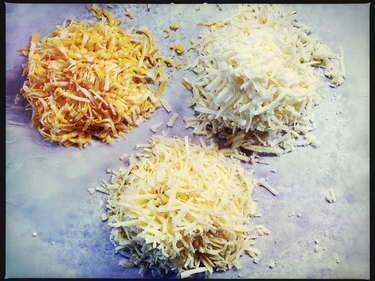
Mozzarella and Monterey Jack, two of the most popular cheeses in the United States, have some characteristics in common and share many culinary applications. However, the two cheeses are quite dissimilar in their heritage, production process, flavor and texture.
If you're considering Monterey Jack vs. mozzarella as a component for a certain dish, or if you're wondering if mozzarella would be a good substitute for Monterey Jack cheese in a recipe, it's important to understand their similarities and differences. Overall, they're both delicious cheeses, and in most circumstances, you can simply choose whichever one you prefer — or perhaps both.
Video of the Day
Video of the Day
A Brief Background
Mozzarella is an Italian cheese that's been produced since antiquity using a relatively simple technique involving stretching and kneading. It's a fresh cheese made from raw or pasteurized cow's milk or water buffalo's milk in certain regions of Italy, and it is eaten soon after production. In the European Union, the name "mozzarella" is protected by a Traditional Specialties Guaranteed certificate, which ensures it's made using traditional techniques. However, no such regulations apply in North America.
Monterey Jack, a semi-hard and mild-flavored cheese, is named for Monterey, California, where it was first produced by Spanish missionaries in the 1700s. Early versions were known as "queso del pais" and used a recipe whose origins can be traced back through Mexico to Spain, where locals learned cheese making from the Romans. In this regard, the heritage of Monterey Jack vs. mozzarella is more alike than it first appears.
The "Jack" part of the name is most commonly attributed to David Jacks, a landowner who acquired over a dozen dairies when he purchased much of what is now Monterey. Jacks was the first to market the cheese outside the local region. However, some sources suggest that "Jack" comes from the name of a press used in making the cheese.
Characteristics of Monterey Jack vs. Mozzarella
Texture: Mozzarella is a semi-soft, fresh curd cheese with a springy texture that turns into strands when you pull it apart. Low-moisture varieties are a little firmer. Monterey Jack is semi-hard with a smooth, firm, nonstringy texture. Both cheeses melt beautifully, turning smooth and creamy without becoming greasy or grainy.
Flavor and aroma: Mozzarella has a very mild flavor and only a slight aroma, both described as fresh and milky. Monterey Jack is also mild but a little more flavorful than mozzarella. Its flavor is often described as buttery and somewhat similar to mild cheddar or Colby cheese (both of which make a great alternative for Monterey Jack cheese). A spicy version called pepper jack is also available as is Colby-Jack, which is Monterey Jack marbled with Colby cheese.
Appearance: Monterey Jack cheese is pale yellow with a thin, edible rind. It's commonly sold in blocks, slices, cubes and preshredded by the bag. Mozzarella is traditionally formed into tight, rindless balls or braids as well as bite-sized balls called bocconcini, which are packed in brine or whey or vacuum sealed. Low-moisture versions of mozzarella might come in a block, slices, cubes or preshredded.
Culinary Uses of Monterey Jack and Mozzarella
Given their origins, it's no surprise that mozzarella is most commonly associated with Italian cuisine and Monterey Jack with Mexican and Spanish cuisine. Mozzarella stars in a caprese salad, where its mild creaminess beautifully balances ripe tomatoes and fragrant fresh basil.
Monterey Jack's meltability makes it ideal for quesadillas and for topping chicken tortilla soup, tacos and nachos. It can also take the place of mozzarella in pizza and pasta dishes, while mozzarella can be a suitable (albeit a little blander) substitute for Monterey Jack cheese in some recipes. Both are nice in salads and for snacking.
Nutritional Profile of Monterey Jack vs. Mozzarella
Monterey Jack is slightly higher in calories than mozzarella, with 106 calories per ounce compared to 85. It's also a little higher in fat and calcium. The two cheeses are close to identical in terms of protein, cholesterol, sodium and most vitamins and minerals.